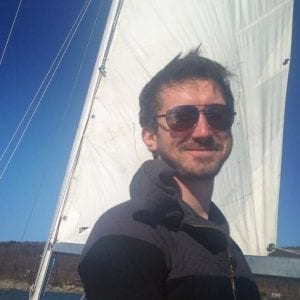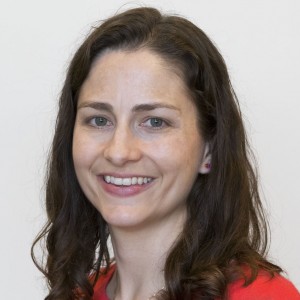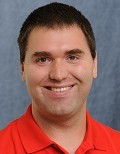SGRS 2018
Riley Schutt
 Bio: Riley Schutt is the Innovation, Research & Development Performance Analyst at the US Sailing team, working to win gold at the 2020 Olympics. Riley received his PhD in Aerospace Engineering working with Professor Charles Williamson in the Fluid Dynamics Research Laboratories at Cornell University. After growing up sailing on Cayuga Lake, Riley has pursued a career in the performance modeling and design of racing yachts. In addition to his current Olympic work, he has worked as a designer in the America’s Cup, Volvo Ocean Race, Vendée Globe, and on numerous one-off record breaking ocean racers.
Bio: Riley Schutt is the Innovation, Research & Development Performance Analyst at the US Sailing team, working to win gold at the 2020 Olympics. Riley received his PhD in Aerospace Engineering working with Professor Charles Williamson in the Fluid Dynamics Research Laboratories at Cornell University. After growing up sailing on Cayuga Lake, Riley has pursued a career in the performance modeling and design of racing yachts. In addition to his current Olympic work, he has worked as a designer in the America’s Cup, Volvo Ocean Race, Vendée Globe, and on numerous one-off record breaking ocean racers.
Abstract: The Engineering of Olympic Sailing
The US Sailing team is enthusiastically preparing for the 2020 Olympics in Tokyo Japan. In 2017 the US Team created an Innovation, Research & Development group to focus on creating technical advantages for the team. Concepts that started with research at Cornell University are now being used to increase coaching effectiveness, identify fast sailing techniques, and increase boat performance. In this talk we explore how PhD research into the vortex dynamics and working for an Ithaca area startup have turned into a career focused on the design and analysis of high performance sailboats. Additional we present opportunities to partner with the US Sailing team for collaborative research and on student projects that will help in the team’s quest for gold in 2020.
SGRS 2017
Jacque Cole
 Bio: Jacque Cole is an Assistant Professor in the Joint Department of Biomedical Engineering at North Carolina State University and the University of North Carolina-Chapel Hill, and she is the director of the Orthopaedic Mechanobiology Lab (OML). She received a Bachelor of Mechanical Engineering (B.M.E.) degree from Auburn University in 2001 and an M.S. and Ph.D. in Mechanical Engineering (with minors in Biomedical Engineering and Biometry) from Cornell University in 2004 and 2007, respectively. She then completed two postdoctoral fellowships at the University of Michigan in Chemistry (2007-2010) and Orthopaedic Surgery (2010-2013). In 2015, she received an NIH K12 award through the Northwestern University Program in Movement and Rehabilitation Sciences to study the physiological mechanisms of bone loss following stroke, and she recently received an NIH R21 to investigate the parallel development of bone and muscle impairments in the shoulder following neonatal nerve injury, a collaborative project with Dr. Kate Saul (NC State Mechanical & Aerospace Engineering). The overall goal of Dr. Cole’s research is to improve current therapeutic strategies for treating and preventing bone loss associated with aging, disease, and injury.
Bio: Jacque Cole is an Assistant Professor in the Joint Department of Biomedical Engineering at North Carolina State University and the University of North Carolina-Chapel Hill, and she is the director of the Orthopaedic Mechanobiology Lab (OML). She received a Bachelor of Mechanical Engineering (B.M.E.) degree from Auburn University in 2001 and an M.S. and Ph.D. in Mechanical Engineering (with minors in Biomedical Engineering and Biometry) from Cornell University in 2004 and 2007, respectively. She then completed two postdoctoral fellowships at the University of Michigan in Chemistry (2007-2010) and Orthopaedic Surgery (2010-2013). In 2015, she received an NIH K12 award through the Northwestern University Program in Movement and Rehabilitation Sciences to study the physiological mechanisms of bone loss following stroke, and she recently received an NIH R21 to investigate the parallel development of bone and muscle impairments in the shoulder following neonatal nerve injury, a collaborative project with Dr. Kate Saul (NC State Mechanical & Aerospace Engineering). The overall goal of Dr. Cole’s research is to improve current therapeutic strategies for treating and preventing bone loss associated with aging, disease, and injury.
SGRS 2017 Keynote Abstract: Vascular function is vital for bone health, yet it is often overlooked in skeletal research. Bone will not develop or heal without a functional vascular network, and a number of clinical conditions involve both vascular decline and bone loss, including aging, obesity, and stroke. However, exactly how the vasculature interacts with bone is not well understood, such as how particular aspects of bone are altered by changes in vascular signaling and blood flow. My lab perturbs vasculature systemically with established mouse models of obesity and stroke to determine the impact of vascular changes on bone metabolism and mechanics. We believe that osteovasculature is a novel therapeutic target for treating and preventing bone loss in several clinical contexts. Understanding more about the expression of various cytokines, particularly those involved in tissue crosstalk (e.g., bone-vasculature, muscle-bone, muscle-vasculature), will expand our understanding of the mechanisms involved in these processes and will be critical for developing drugs or physical therapies to mitigate bone loss with vascular-related conditions like obesity and stroke. Understanding how osteovasculature changes with obesity and stroke and how that impacts bone metabolism and mechanics, as well as the physiological mechanisms involved with exercise or exercise-like interventions, are critical first steps for developing new rehabilitation strategies that address the bone loss experienced with these conditions.
SGRS 2016
Matthew Bryant

Bio: Matthew Bryant is an Assistant Professor of Mechanical and Aerospace Engineering at NC State University and the director of the Intelligent Systems and Structures Research Lab (iSSRL). Dr. Bryant received the B.S. degree in mechanical engineering from Bucknell University in 2007 and the M.S. and Ph.D. degrees in mechanical engineering from Cornell University in 2011 and 2012 respectively. Dr. Bryant’s research interests include the dynamics and control of smart structures and mechatronic systems with applications to novel actuation techniques, energy harvesting devices, fluid-structure interactions, and robotics in the land, air, and underwater domains. Dr. Bryant is the recipient of the Teledyne Scientific Partner of the Year Award in 2015, the Intelligence Community Postdoctoral Fellowship in 2012, the Oliver J. Decker Prize in 2007, and the Ernest and Josephine Christensen Award in 2007. Since beginning his faculty position in 2013, Dr. Bryant has been awarded grants from the National Science Foundation, DARPA, and the North Carolina Space Grant.
SGRS 2016 Keynote Abstract: Nature offers myriad examples of highly-optimized solutions to problems ranging from sensor design to multifunctional structures to locomotion modalities. While often beautiful to observe and mimic superficially, much more substantive technological gains can be achieved by developing an understanding of the complex ways living organisms interact with and manipulate their environments. Taking advantage of bio-inspiration motivates us to develop and leverage phenomenological models, design techniques, transducers, and structures beyond what traditional engineering practice has offered.
In this talk, I will highlight several research efforts in applying multidisciplinary bio-inspired engineering design, active materials and structures, and multi-domain coupling to create novel energy harvesters, actuators, and robotic systems. I will present ongoing work that aims to take advantage of fish-like oscillating fins or membranes for harvesting kinetic energy from wind and water flows. This problem leads to modeling and experimental investigations of coupling and interactions among the fluidic, structural, and electrical domains, as well as advantageous nonlinear, unsteady, and multi-body dynamic behaviors. Another research thrust draws inspiration from the variable recruitment capabilities of natural skeletal muscle to develop soft fluidic actuators that improve efficiency by adaptively varying their active geometry. This approach can allow a compliant actuator bundle to selectively pressurize or vent actuation elements to perform online force control and mechanical impedance matching while minimizing fluid energy consumption and valve throttling losses. Finally, I will discuss progress and opportunities in designing robots and unmanned vehicles with bio-inspired architectures and operating concepts.
SGRS 2015
Veronica J. Santos

Bio: Veronica J. Santos is an Associate Professor in the Mechanical and Aerospace Engineering Department at the University of California, Los Angeles, and Director of the UCLA Biomechatronics Lab. Dr. Santos received her B.S. in mechanical engineering with a music minor from the University of California at Berkeley (1999), was a Quality and R&D Engineer at Guidant Corporation, and received her M.S. and Ph.D. in mechanical engineering with a biometry minor from Cornell University (2007). While a postdoc at the University of Southern California, she helped to develop a biomimetic tactile sensor for prosthetic hands. From 2008 to 2014, Dr. Santos was an Assistant Professor in the Mechanical and Aerospace Engineering Program at Arizona State University. Her research interests include hand biomechanics, tactile sensors, prosthetics, and robotics for grasp and manipulation. Dr. Santos was selected for an NSF CAREER Award (2010), two ASU Engineering Top 5% Teaching Awards (2012, 2013), an ASU Young Investigator Award (2014), and as an NAE Frontiers of Engineering Education Symposium participant (2010).
Check out a video featuring some of Dr. Santos’ research!
SGRS 2015 Keynote Abstract: Haptic perception remains a grand challenge for artificial hands. Artificial dexterous manipulators could be enhanced by “haptic intelligence” that enables identification of objects and their features via touch alone. This could be especially useful when reliable visual and/or proprioceptive feedback are unavailable. Studies will be presented in which a robot hand outfitted with a deformable, multimodal tactile sensor was used to replay human-inspired haptic “exploratory procedures” to perceive salient geometric features such as edges and fingertip-sized bumps and pits. Tactile signals generated by active fingertip motions were used to extract inputs for support vector classification and regression. The influence of tactile sensor capabilities, exploratory procedure selection, and hand compliance on perception accuracy will be discussed. The ability to perceive local shape could be used to advance semi-autonomous robot systems and to provide haptic feedback to human teleoperators of devices ranging from bomb defusal robots to neuroprostheses.
SGRS 2014
Todd E. Humphreys

Bio: Dr. Todd E. Humphreys is an Assistant Professor of Aerospace Engineering and Engineering Mechanics at The University of Texas at Austin, and director of its Radionavigation Lab. Humphreys, a Cornell alum, received his PhD in 2008 under advisor Prof. Psiaki.
Research:
Dr. Humphreys specializes in the application of optimal estimation techniques to problems in satellite navigation, orbital and attitude dynamics, and signal processing. He directs the Radionavigation Laboratory at UT-Austin, where software-defined GPS receivers are developed as a platform for GPS technology innovation and study of the ionosphere and neutral atmosphere. His recent focus has been on defending against intentional GPS spoofing and jamming. In 2008 he co-founded Coherent Navigation, a startup that hardens GPS by, among other things, exploiting telephony signals from the Iridium satellite constellation. Learn more about him and his research here, here, and here.
Keynote talk:
Prof. Humphreys spoke on March 6, 2014, the day before the symposium. Dr. Humphreys’s talk focused on two related topics: (1) navigation and timing security for autonomous systems, and (2) mainstreaming cm-accurate GNSS.
The next few decades will see pervasive autonomous control systems become critical to the world economy—from autonomous cars and aircraft to smart homes, smart cities, and vast energy, communication, and financial networks controlled at multiple scales. Protecting these systems from malicious attacks is a matter of urgent societal interest. The study of secure control has made important advances over the past few years, but these constitute not solutions so much as problem framing and an emerging consensus that traditional fault detection and mitigation fails when confronted with a deliberate attacker: outlaws are different from outliers; fraud is different from faults. Moreover, the vast majority of this early literature focuses only on cyber attacks—infiltration of the communications networks over which sensor measurements y and control commands u are conveyed.
This talk focused on a new category of attack models that have not been previously treated in the secure control literature. Like cyber attacks, these attacks are hard to detect and can be executed from a distance, but unlike cyber attacks, they are effective even against control systems whose communications networks are secure, and so can be considered a more menacing long-term threat. Moreover, this category is subject to realistic physical (as opposed to questionable artificial) constraints on how y can be manipulated, which offers hope for substantial theoretical progress toward effective attack detection and survival. These are field attacks: attacks on the physical fields—electromagnetic, acoustic, pressure, etc.—measured by system sensors. I emphasize field attacks against control systems performing precise navigation and timing functions, as these are of special importance to the rise of autonomous vehicles.
Separately, Dr. Humpreys discussed an effort underway at the University of Texas to push centimeter-accurate satellite positioning onto smartphones to enable a convincing, immersive, spontaneous augmented reality experience without the need for a prior map or for fiducial markers.